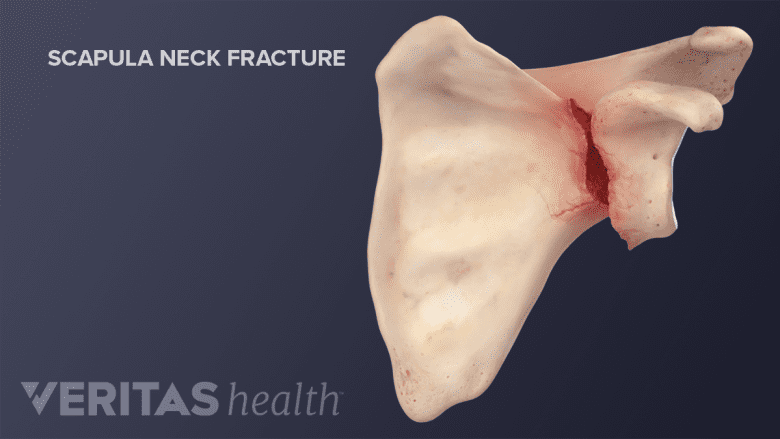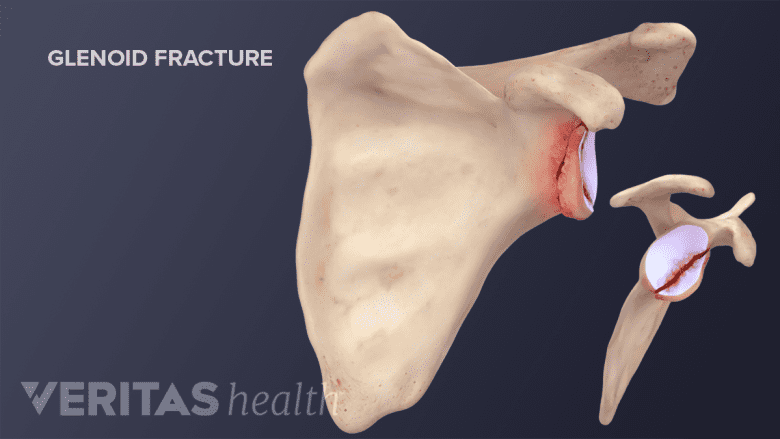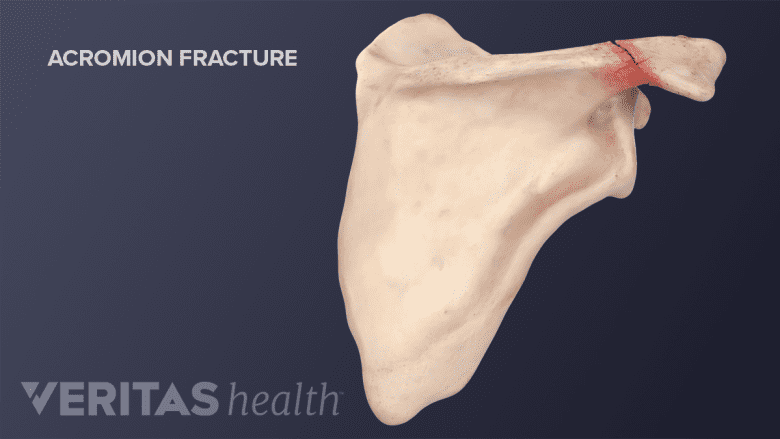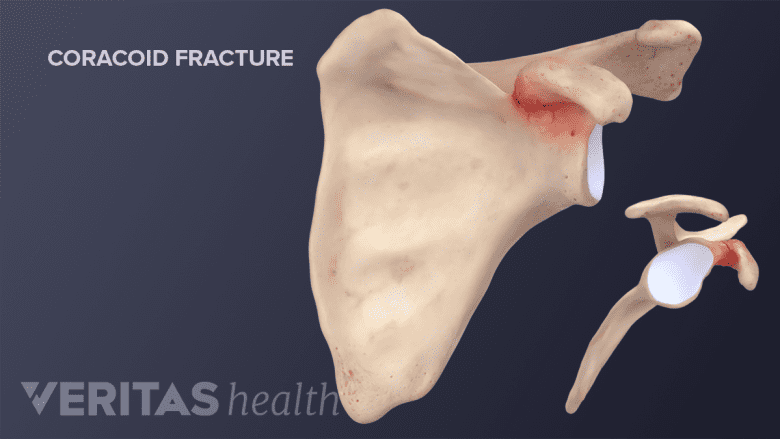A broken scapula is a complete or partial break in the shoulder blade – the triangular-shaped bone at the back of the shoulder.
The scapula is strong and sturdy bone, and scapular fractures are the least common type of shoulder fractures.
The scapula connects the collarbone (clavicle) and upper arm bone (humerus), providing structural integrity and movement of the shoulder joint. An ensemble of 18 muscles attaches to the scapula,1Libby C, Frane N, Bentley TP. Scapula Fracture. [Updated 2023 Jul 17]. In: StatPearls [Internet]. Treasure Island (FL): StatPearls Publishing; 2024 Jan-. Available from: https://www.ncbi.nlm.nih.gov/books/NBK537312/ creating a robust connection between the ribs, spine, and arms.
In This Article:
- A Broken Shoulder: Scapula Fracture
- Scapula Fracture Causes and Symptoms
- Treating a Scapula Fracture
What Is a Scapula Fracture?
Scapular fractures compromise the movement and stability of the shoulder joint.
The essential points to know about a broken scapula are:
- Scapular fractures are relatively rare. They make up fewer than 1% of all fractures in the body and only 3% to 5% of shoulder fractures.1Libby C, Frane N, Bentley TP. Scapula Fracture. [Updated 2023 Jul 17]. In: StatPearls [Internet]. Treasure Island (FL): StatPearls Publishing; 2024 Jan-. Available from: https://www.ncbi.nlm.nih.gov/books/NBK537312/
- Up to 90% of scapula fractures occur in young individuals and are caused by high-intensity trauma.1Libby C, Frane N, Bentley TP. Scapula Fracture. [Updated 2023 Jul 17]. In: StatPearls [Internet]. Treasure Island (FL): StatPearls Publishing; 2024 Jan-. Available from: https://www.ncbi.nlm.nih.gov/books/NBK537312/
- These fractures are very painful and severely limit shoulder function.
- A scapula is a large sturdy bone divided into many parts, and a fracture can involve one or more of these parts.
- A scapular fracture typically results from a high-impact injury and is often accompanied by injuries to other parts of the body, such as the collarbone, upper spine, head, lungs, ribs, and/or spinal cord.
- The fractures typically heal well with medical treatment and most patients regain complete shoulder function after the injury heals.
Watch Causes of Shoulder Blade Pain Video
While a fractured scapula is a type of broken shoulder, most shoulder fractures (up to 95%) affect the other two bones in the shoulder joint: the clavicle (collarbone) and humerus (upper arm bone).
Types of Scapula Fractures Based on Location
Broken shoulder blades are classified based on the specific part of the bone that is affected and include:
Scapular body fractures
These fractures occur in the large, flat, triangle-shaped area of the scapula, called the scapular body.
The scapular body is the most frequently fractured part, accounting for 50-60% of all scapular fractures.2Scapula (Shoulder Blade) Fractures. American Academy of Orthopaedic Surgeons website. https://orthoinfo.aaos.org/en/diseases--conditions/scapula-shoulder-blade-fractures. Last reviewed Nov 2023. Accessed Aug 16, 2024.
Scapular neck fractures
These fractures involve the narrow region connecting the body of the scapula to the glenoid fossa, called the scapular neck.
These fractures occur in approximately 25% of cases.2Scapula (Shoulder Blade) Fractures. American Academy of Orthopaedic Surgeons website. https://orthoinfo.aaos.org/en/diseases--conditions/scapula-shoulder-blade-fractures. Last reviewed Nov 2023. Accessed Aug 16, 2024.
Glenoid fractures
These fractures affect the glenoid cavity – the shallow socket that articulates with the “ball” or head of the humerus (upper arm bone).
Acromion fractures
These fractures affect the acromion, a bony projection of the scapula located at the top-most part of the shoulder, forming a joint with the end of the clavicle (the acromioclavicular joint).
Coracoid fractures
These bone breaks involve the coracoid process – a curved, hook-like projection in the front of the scapula located under the clavicle, between the shoulder’s ball and socket and the first rib.
Types of Scapula Fracture Based on Stability and Displacement
Comminuted fractures are one of the most severe types of scapular fractures.
The fractures are also classified according to the severity of the injury:
- Stable fractures: Involve a clean break without significant displacement of the bone fragments. They are often caused by direct blows to the shoulder. A hairline or stress fracture in the shoulder blade is a type of stable fracture.
- Displaced fractures: The bone fragments become displaced and move away from their correct anatomical location. They occur due to a severe impact or a twisting injury.
- Compound fractures: The broken bone punctures the skin, exposing the bone fragment.
- Avulsion fractures: A small piece of bone dislodges from the main bone due to the force of a muscle or tendon. Scapular avulsion fractures typically involve the coracoid process or the acromion.
- Comminuted fractures: The scapula breaks into multiple bone fragments, making it difficult to realign and stabilize.
The treatment for scapula fractures depends on the type of fracture, the severity of the injury, and the patient's overall health.
How Long Does a Fractured Scapula Take to Heal?
The healing time for a broken scapula varies depending on the severity of the injury and the type of treatment required.
- Generally, most scapula fractures heal within a few months.
- It can take up to a year (or more) to completely restore shoulder motion and function.
- Simple fractures heal faster than complex fractures.
- Displaced fractures may take longer to heal.
- If surgery is necessary, the healing time may be longer.
The patient’s age, overall health, and adherence to treatment also influence healing time.
How to Speed Up Fracture Healing?
To expedite bone healing, patients are encouraged to combine medical care with self-care practices. Immobilizing the fracture, ensuring sufficient rest, engaging in recommended exercises, and consuming a diet rich in bone-building nutrients all contribute to optimal recovery and healing time.
When to See a Doctor
A scapula fracture following a traumatic event or a suspected fracture with the following symptoms and signs warrants immediate medical attention:
- Break in the skin or tenting (cone-shaped bulge) of the skin with visible bone protrusion
- Neurologic deficits such as numbness or weakness in the arm or hand on the affected side
- Decreased blood flow to the arm (diminished pulse)
- Drooping or sagging shoulder
- Severely swollen shoulder
- Severe bleeding
- Difficulty breathing
- Chest pain
- Abdominal pain
- Coughing up blood
Prompt evaluation and treatment of a fractured scapula ensures adequate bone healing and prevents complications such as nonunion of the fractured ends.
Scapula fractures are often first diagnosed by an urgent care or emergency room (ER) physician and follow-up care is provided by orthopedic surgeons or sports medicine specialists. These physicians usually coordinate care with physical therapists and primary care doctors.
- 1 Libby C, Frane N, Bentley TP. Scapula Fracture. [Updated 2023 Jul 17]. In: StatPearls [Internet]. Treasure Island (FL): StatPearls Publishing; 2024 Jan-. Available from: https://www.ncbi.nlm.nih.gov/books/NBK537312/
- 2 Scapula (Shoulder Blade) Fractures. American Academy of Orthopaedic Surgeons website. https://orthoinfo.aaos.org/en/diseases--conditions/scapula-shoulder-blade-fractures. Last reviewed Nov 2023. Accessed Aug 16, 2024.












